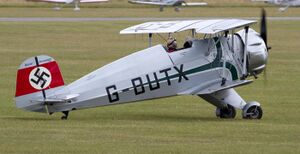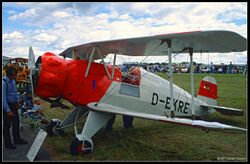Engineering:Bücker Bü 133
| Bü 133 Jungmeister | |
|---|---|

| |
| Bü 133C Jungmeister at Flying Legends (2011) | |
| Role | Single-seat advanced trainer |
| National origin | Germany |
| Manufacturer | Bücker, CASA Dornier |
| Primary users | Luftwaffe Spain Switzerland |
| Number built | around 250 |
| Developed from | Bücker Bü 131 |
The Bücker Bü 133 Jungmeister (Young master) was an advanced trainer of the Luftwaffe in the 1930s. It was a single-engine, single-seat biplane of wood and tubular steel construction and covered in fabric.
Development
The Bü 133 was a development of the Bücker Bü 131 Jungmann two-seat basic trainer. First flown in 1935 (by Luise Hoffmann, the first female works pilot in Germany),[1] it was slightly smaller than the Bü 131. The prototype, D-EVEO, was powered by a 140 hp (104 kW) Hirth HM506 inverted, air-cooled inline-6 engine.[1]
The aircraft showed "astonishing agility" at its first public appearance, the 1936 International Aerobatic Championship at Rangsdorf,[1] but the Bü 133A garnered no orders; only two Bü 133Bs, with 160 hp (119 kW) version of that same Hirth HM506 inline-6 engine, were built.[1]
The main production type was the 160 hp (119 kW) Siemens-Bramo Sh 14A radial powered Bü 133C, which had a distinctive cowling and a 13 cm (5.1 in)-shorter fuselage,[1] and the same fine aerobatic performance as the Bü 133A.[1]
Fifty-two were manufactured under licence by Dornier for the Swiss Air Force [1] (which kept it in service until 1968),.[1] A similar number were built for the Spanish Air Force by CASA, and were designated the CASA 1-133.
Operational history
The Bü 133C racked up numerous victories in international aerobatic competition, and by 1938 was the Luftwaffe's standard advanced trainer.[1] At the Brussels meet that year, a three-man Luftwaffe team made a strong impression on Reichsmarschall Hermann Göring, who ordered a nine-man team be formed.[1] It dazzled the crowds at the International Flying meet in Brussels the next year.[1]
The Jungmeister design remained competitive in international aerobatic competition into the 1960s.[1]
Variants
- Bücker Bü 133A
- Hirth HM 6 inline engine: 135-hp (101-kW)
- Bücker Bü 133B
- applied to licence-built aircraft (only two versions were ever constructed of this variant).
- Bücker Bü 133C
- Siemens Sh 14A-4 engine
- CASA 1.133
- Spanish-built variant.
- Price/American Tiger Club Jungmeister
- Plans for homebuilt construction.[2]
- SSH Bü 133 Jungmeister
- Reproduction Jungmeister by SSH in Poland.
Operators
 Independent State of Croatia
Independent State of Croatia
 Nazi Germany
Nazi Germany
- Luftwaffe
 Lithuania
Lithuania
- Lithuanian Air Force (6 acquired in 1939)[3]
 Poland
Poland
- Polish Air Force (1 bought for tests before 1939)[4]
 Romania
Romania
 Slovakia
Slovakia
 South Africa
South Africa
 Switzerland
Switzerland
 Yugoslavia
Yugoslavia
- SFR Yugoslav Air Force - Postwar.
 Hungary
Hungary
Specifications (Bücker Bü 133C)
Data from The Concise Guide to Axis Aircraft of World War II - David Mondey[6]
General characteristics
- Crew: 2
- Length: 6 m (19 ft 8 in)
- Wingspan: 6.6 m (21 ft 8 in)
- Height: 2.2 m (7 ft 3 in)
- Wing area: 12 m2 (130 sq ft)
- Airfoil: Clark Y modified[7]
- Empty weight: 425 kg (937 lb)
- Max takeoff weight: 585 kg (1,290 lb)
- Powerplant: 1 × Siemens-Halske Sh.14A-4 9-cylinder air-cooledradial piston engine, 119 kW (160 hp)
- Propellers: 2-bladed fixed-pitch propeller
Performance
- Maximum speed: 220 km/h (140 mph, 120 kn)
- Cruise speed: 200 km/h (120 mph, 110 kn)
- Range: 500 km (310 mi, 270 nmi)
- Service ceiling: 4,500 m (14,800 ft)
See also
Related development
Related lists
- List of aircraft of the Spanish Republican Air Force
- List of Interwar military aircraft
- List of military aircraft of Germany
References
Notes
- ↑ 1.00 1.01 1.02 1.03 1.04 1.05 1.06 1.07 1.08 1.09 1.10 1.11 Ketley, Barry, and Rolfe, Mark. Luftwaffe Fledglings 1935–1945: Luftwaffe Training Units and their Aircraft (Aldershot, GB: Hikoki Publications, 1996), p.14.
- ↑ Air Trails: 79. Winter 1971.
- ↑ http://www.plienosparnai.lt/page.php?977) in Lithuanian)
- ↑ Morgała, Andrzej Morgała (2003). Samoloty wojskowe w Polsce 1924-1939. Warsaw: Bellona, p. 316. ISBN:83-11-09319-9 (in Polish)
- ↑ SBHAC - Aviones de la Fuerza Aérea de la República Española/Aviones de Escuela y Enlace
- ↑ Mondey, David. The Concise Guide to Axis Aircraft of World War II.
- ↑ Lednicer, David. "The Incomplete Guide to Airfoil Usage". https://m-selig.ae.illinois.edu/ads/aircraft.html. Retrieved 16 April 2019.
Bibliography
- König, Erwin. Bücker Bü 133 "Jungmeister"(Flugzeug Profile 29) (in German). D-86669 Stengelheim, Germany: Unitec Medienvertrieb e.K.,
- König, Erwin. Die Bücker-Flugzeuge (The Bücker Aircraft) (bilingual German/English). Martinsried, Germany: Nara Verlag, 1987. ISBN:3-925671-00-5.
- König, Erwin. Die Bückers, Die Geschichte der ehemaligen Bücker-Flugzeugbau-GmbH und ihrer Flugzeuge (in German). (1979)
- Mondey, David. The Hamlyn Concise Guide to Axis Aircraft of World War II. London: Chancellor Press Ltd. ISBN:1-85152-966-7.
- Smith, J.Richard and Kay, Antony L. German Aircraft of the Second World War. London: Putnam and Company Ltd., 3rd impression 1978, p. 92–93. ISBN:0-370-00024-2.
- Wietstruk, Siegfried. Bücker-Flugzeugbau, Die Geschichte eines Flugzeugwerkes (in German). D-82041 Oberhaching, Germany: Aviatik Verlag, 1999. ISBN:3-925505-28-8.
- Wood, Tony and Gunston, Bill. Hitler's Luftwaffe: A pictorial history and technical encyclopedia of Hitlers air power in World War II. London: Salamander Books Ltd., 1977, p. 140. ISBN:0-86101-005-1.
External links
- Bücker Bü 133 page on luftarchiv.de
- Photogallery on Airliners.net
- Bücker Museum Rangsdorf's online Bü 133C Jungmeister structural detail photos pages
- Bücker Bü 133 page of Smithsonian National Air and Space Museum
- Bücker Bü 133 C page of Virginian Aviation Museum



